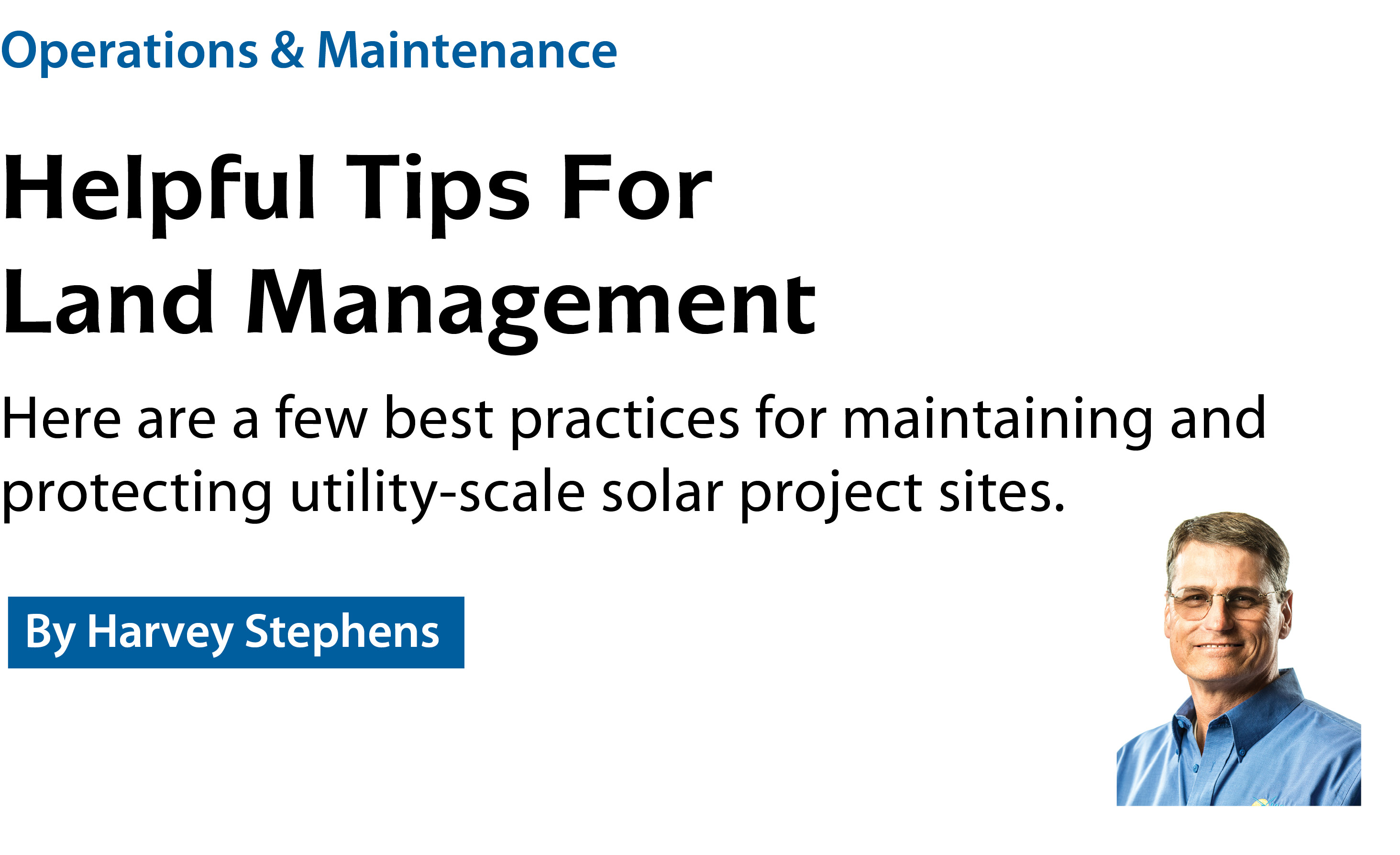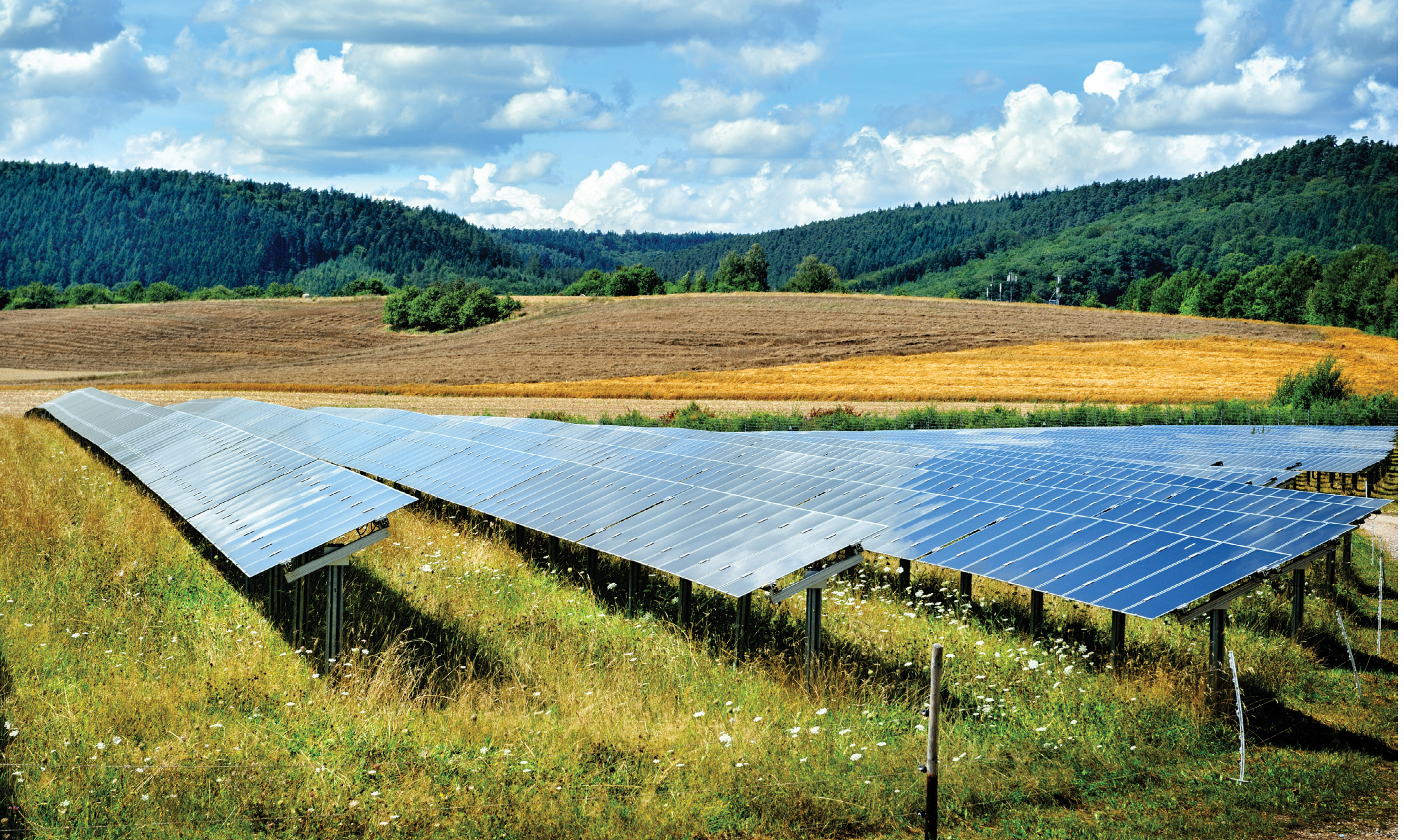

301 Moved Permanently
Providing adequate land management in the field for utility-scale solar projects requires a diverse toolbox of solutions, and solar energy professionals, especially on the operations and maintenance (O&M) side, should establish preventive measures now, rather than risk dealing with big problems later.
Without proper land management, utility-scale solar projects face a variety of negative impacts, including damage to roads, expensive equipment and buildings. The worst-case scenario might be a mudslide or a fire, either of which can destroy an entire project in one fell swoop and cause not only major setbacks, but also financial devastation. The not-so-worst case might be tumbleweeds, which can still cause some serious problems.
The coming of fall in the U.S. continues the dry fire season, which will be followed by winter’s rain and snow and the potential for erosion, water intrusion and flooding. O&M strategies can help prepare for such seasonal events detrimental to utility-scale solar projects.
Fire prevention & abatement
A wet growing season is a blessing for farmers, ranchers and watersheds; however, as new vegetation reaches maturity, it’s not exactly a blessing for solar projects. Dry vegetation is an extreme fire hazard.
During dry conditions, project owners and operators can most likely expect visits from fire officials. Most municipalities or county fire departments have vegetation management rules regarding the removal or mowing of vegetation to a prescribed height before the start of each fire season. Furthermore, inspections are conducted throughout the dry season, so it’s important to stay in compliance with regulations.
For solar power facilities, managing vegetation near equipment where an ignition source could occur is essential. Around power transformers and inverters, vegetation should be removed from the ground in a radius of no fewer than 15 feet. Clearing this radius will help prevent a fire from starting if the component has a major failure that causes sparks. Similarly, clearing a 10-foot radius around power poles will help prevent a fire, and trees and other large brush should be cleared at least eight feet below a power line. Inside the substations, fenced parameters should be removed to bare ground or rock.
In the solar fields, however, low-growing vegetation can serve as a means of mitigating dust, so mowing vegetation to a height of four inches is a best management practice to minimize the fire hazard while allowing low ground cover to provide dust prevention.
Fire safety can also start with mowing, itself, as one small spark from a mower or mower’s blade can result in a big fire. Given the cost of assets that are at stake on solar fields, a project owner should turn to safety-conscious, licensed professionals with proven track records.

In areas with arid climates, such as Southern California, we recommend two mowings per year, starting around May through October. Regions with more rainfall, however, may require as many as five mowings per year in order to keep up with vegetation growth.
A variety of equipment and chemical strategies can help combat weeds. It is important to consult the conditional use permit, which often details vegetation or re-vegetation requirements for the site and a plan for preventing storm water pollution. The site should be mowed prior to applying any weed killers to provide uniform application. Pre-emergent herbicides should be applied prior to a rainy season, as rain will drive the chemical into the soil, killing undesirable species at their roots.
In arid regions, one of the biggest weed challenges is contending with windblown tumbleweeds (also known as Russian Thistle). Tumbleweeds can cause serious problems when they shadow panels or interfere with tracking systems, cable trays, pylons, inverters and so forth. As mentioned before, it is better to be proactive than reactive, and that is especially true with tumbleweeds. Tumbleweeds can produce up to 200,000 seeds each if they’re not removed from the site, and they also contain oils that can be very flammable. It is best to mow them while they are still green and physically remove them from the site.
Maintaining roads will also help if a brush fire occurs. Most roads in high-risk fire areas need a 20-foot distance on either side after a project has been constructed, allowing for access and acting as a fire break. Using parameter roads and fence lines as a fire break is a site’s best defense against the spread of fire whether the source is internal or external. Keeping the ground cover and fence line maintained may mean seasonal inspections and services to remove windblown vegetation that has accumulated. Vegetation in fence lines can become a tinder box, so this has to be cleared throughout a fire season, too.
In addition to knowledgeable O&M providers, the county fire department is often another great source for assistance in identifying potential fire risk, and it’s a good idea to invite fire officials on-site to help with a proactive approach. Plus, wouldn’t it be much better to meet the fire department during preventive work than if it were too late and a fire broke out?
Hydroseeding
When a land management team is not mowing, it is sowing seeds to stabilize slopes and retain soil. Proper land management can go a long way in preventing or controlling erosion and other detrimental events on solar energy sites. Before winter season brings precipitation, it’s a good time to think about hydroseeding.
Hydroseeding is one of the most common and effective seeding techniques, especially under panels or on rough or uneven terrain. It promotes quick seed germination and is an efficient, cost-effective way to apply seeds, mulch and fertilizer to recently disturbed soils found on construction projects. The value of hydroseeding can be seen in both erosion control and dust mitigation. It’s also an effective re-vegetation strategy after a project is built.
Seed mix, mulch rate, fertilizer, application uniformity, overspray mitigation and other factors need to be well thought out in advance of prepping the soil and hydroseeding. Once an O&M provider gains an understanding of the site environment, choosing the right seed is one of the most important factors in hydroseeding, as the seed mix needs to match the natural vegetation. Because seed mix varies by region, contractors should create custom plans for each project. What gets planted in the Mojave Desert in California is very different from what gets planted in Greensboro, N.C. Furthermore, the seed mix can change the price per acre by hundreds of dollars. Because project sites can range from a few acres to 2,000 acres, the price difference can represent significant savings.
Nonetheless, hydroseeding is certainly an instance when choosing the best quality is more important than price alone. It is important to work with an unbiased consultant to select the appropriate seeds for the project site’s climate and soil content, as some suppliers will recommend only seeds and other products they carry. Understanding the soil structure and texture is also essential because these attributes can indicate water retention capabilities and how much mulch should be used. The best time to apply the hydromulch is in advance of natural rainfall, which starts the germination process. In Southern California, for example, the rainy season is October through March.
Wet weather preparation
Before the rain or snow hits, it’s important for solar professionals to review the regulatory requirements as dictated by the site-specific storm water pollution prevention plan to gain a detailed understanding of expectations for water retention and pass-through, sampling frequencies, testing, and record retention. With this knowledge, the next step is to create a standard operating procedure (SOP) for wet weather events and develop personnel training so that adherence to the SOP becomes procedure-driven company wide.
Many utility-scale solar fields are constructed on or around dry lake beds where land is inherently flat and soil percolation is minimal. Typically, this means that even a minimal amount of rain can create storm water movement as designed by the grading plan.
Water always behaves the same way; it seeks its own level. What does change, however, is the topography and elevation in the settling points. As soil is deposited, it diminishes the volume of a drainage route or a retention basin. Therefore, drainage routes and basins near projects must be cleared of obstructions, dirt and debris that might have accumulated. Flow channels, swales, riprap beds and culverts need to be cleaned out to allow unrestricted water passage. Fencing can also restrict water flow, as floating debris builds up, creating a beaver dam effect. Look for areas where water flow passes under fencing and remove any accumulated debris.
In addition to removing debris, trash and silt buildup, O&M providers should make any repairs necessary to drain grates, catch basins, inlets, channels and roadways in order to ensure storm water flows freely. They should pay close attention to culverts under roadways, using adequate lighting to inspect and ensure unobstructed water passage. Maintaining a channel cleaning and maintenance program that addresses vegetation trimming, debris, sediment and trash in those flood channels is also essential.
Blockage in culverts can lead to water flowing over roadways and also erode or destroy site access infrastructure. To help prevent this, swales or drainages leading into basins must be intact and capable of carrying storm water at a controlled rate. A breach in a drainage route or flow path negates the design capabilities to move water across the property or into an appropriate catch basin. A good rule of thumb to follow is “inspect what you expect” by looking at the “story marks” on the property from the last wet weather event.
Additionally, roadways that provide critical site access should be constructed above grade with a road-base type of material. To maintain or prepare non-paved roads for wet conditions, soil stabilizers can be added periodically to bind the base material together to prevent wet weather deterioration. This also helps to minimize dust in the dryer months.
Conclusion
O&M professionals should be aware that improper land management can create a variety of negative impacts on utility-scale solar projects, including damage to roads, equipment and buildings. The risk of fire is high on solar sites where vegetation is unmanaged. When heavy rains come, there is the potential for erosion and flooding. Proactive O&M providers should take every necessary step they can to minimize damage and be responsible stewards of solar assets.
Operations & Maintenance
Helpful Tips For Land Management
by Harvey Stephens
Here are a few best practices for maintaining and protecting utility-scale solar project sites.
si body si body i si body bi si body b
si depbio
- si bullets
si sh
si subhead
pullquote
si first graph
si sh no rule
si last graph